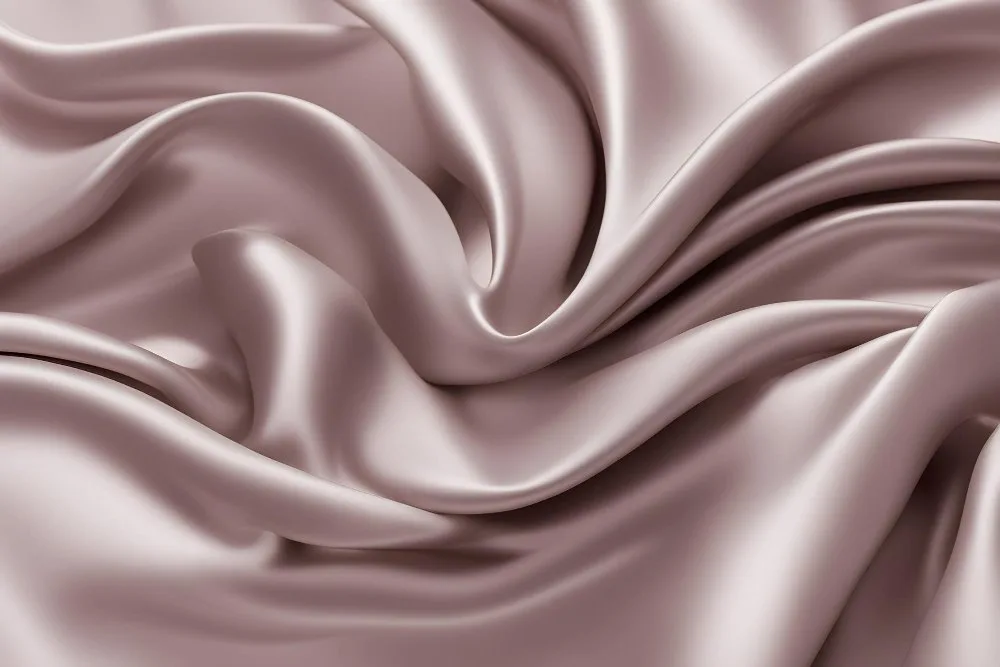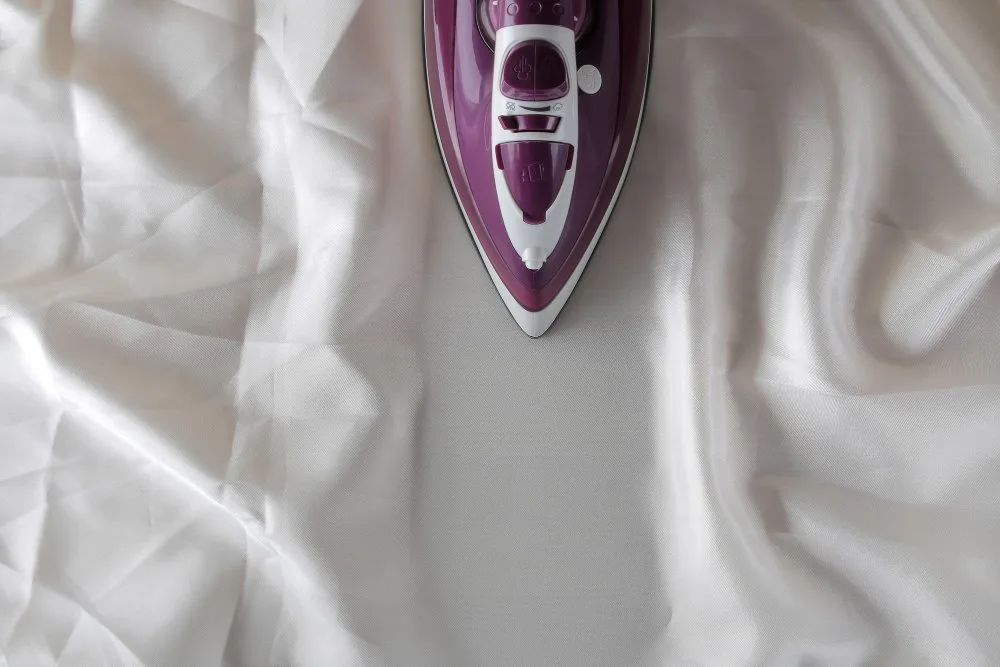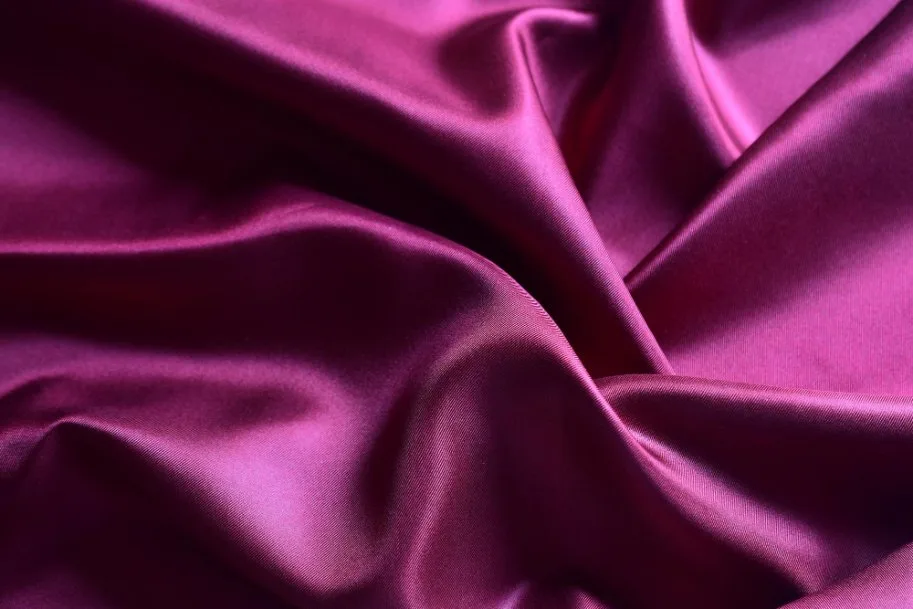Your go-to resource for understanding silk from production to purchase
Silk has been the gold standard of luxury fabrics for thousands of years. But what makes this material so special? Whether you’re a fashion lover, textile student, or just curious about silk, this guide breaks down everything you need to know about the world’s most prized natural fiber.
Table of Contents
- What is Silk Fabric?
- The Rich History of Silk
- How Silk is Made: The Sericulture Process
- 20 Types of Silk Fabric Explained
- Understanding Silk Grades: 6A to Grade C
- Properties and Benefits of Silk
- Advantages and Disadvantages of Silk
- How to Tell if a Fabric is Real Silk
- How to Wash and Care for Silk
- Silk vs Other Fabrics
- Uses and Applications
- Sewing with Silk: Tips and Techniques
- Sustainability and Ethics
- Silk Trends in 2025
- Buying Guide: What to Look For
- Frequently Asked Questions
What is Silk Fabric?
Silk is a natural protein fiber produced by certain insect larvae to form cocoons. The most common type comes from the Bombyx mori silkworm, which feeds exclusively on mulberry leaves. What sets silk apart from other natural and synthetic fabrics is its unique combination of strength, softness, and natural shine.
What is 100% silk made of? Pure silk consists mainly of fibroin, a protein that silkworms secrete when building their cocoons. Each cocoon contains a single continuous strand of silk that can stretch up to 900 meters (almost 3,000 feet) long. This is what makes silk thread so special compared to shorter plant fibers like cotton or linen.
Quick Fact: One silk thread is actually made up of 48 individual silk filaments twisted together. It takes about 2,500 silkworms to produce just one pound of raw silk.
Is silk just polyester? No. This is a common mix-up. Silk is a completely natural fiber from insect cocoons, while polyester is a synthetic fabric made from petroleum. Some manufacturers create “silk-like” polyester fabrics that mimic silk’s appearance, but they lack silk’s natural properties and breathability.
The Rich History of Silk
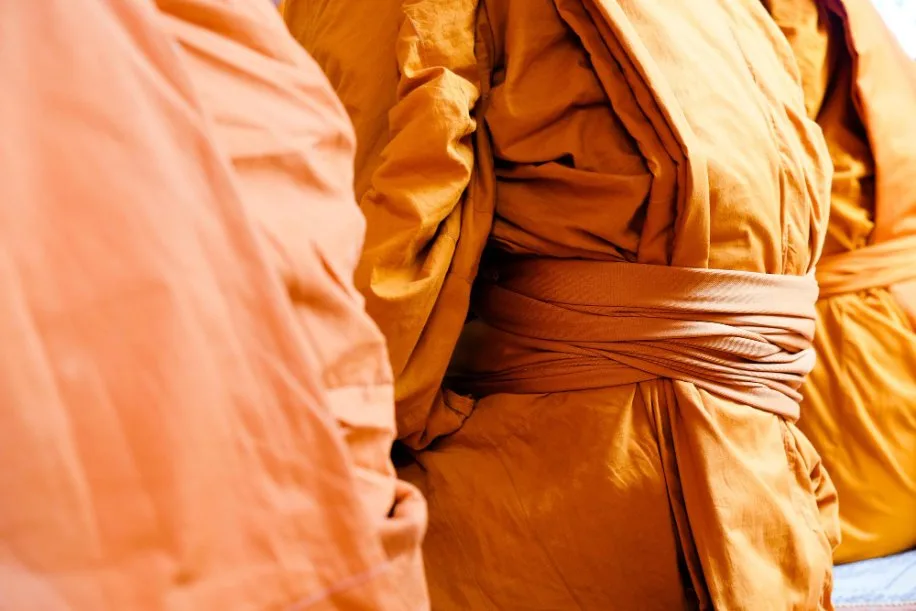
Silk production dates back to ancient China around 2700 BCE. Legend credits Empress Leizu with discovering sericulture (the art of silk making) when a cocoon fell into her tea and began to unravel. Whether true or not, China dominated silk production for centuries, keeping the production methods a closely guarded secret.
Which country is famous for silk? China remains the world’s largest silk producer, responsible for about 60% of global production. However, India, Thailand, and Japan also have rich silk traditions and produce high-quality varieties.
The famous Silk Road wasn’t just a trade route, it was named after silk itself, which was so valuable that it was used as currency. Silk eventually spread to Korea, Japan, India, and by 550 CE, to Constantinople (modern-day Istanbul) when two monks smuggled silkworm eggs out of China in hollow bamboo canes.
How Silk is Made: The Sericulture Process
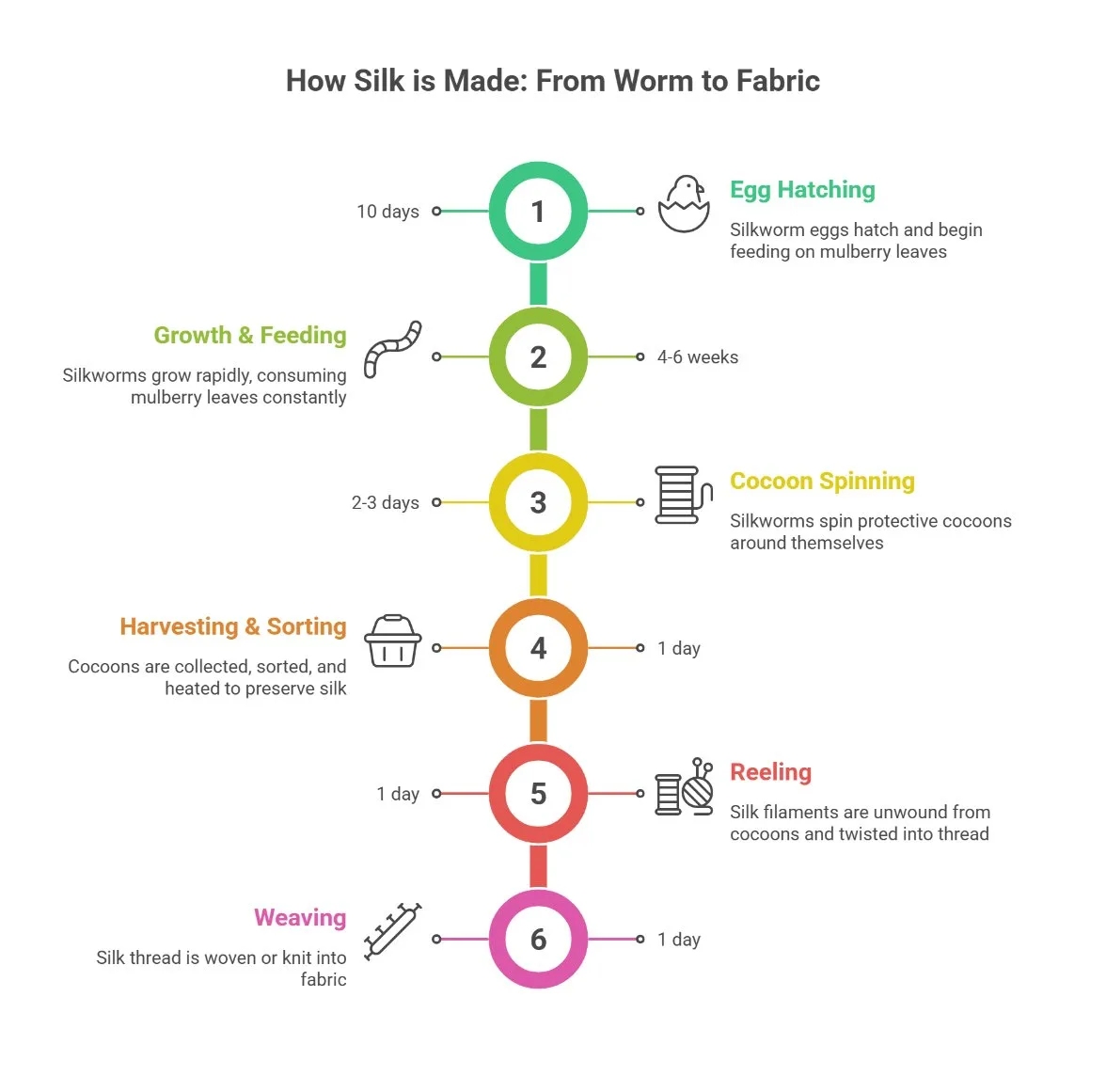
Understanding how silk is made helps you appreciate why it costs what it does. Here’s the fascinating journey from worm to fabric:
The Sericulture Process
- Silkworm Breeding: Female moths lay 300-500 eggs, which are carefully controlled for temperature and humidity.
- Hatching and Feeding: After about 10 days, tiny silkworms hatch and eat mulberry leaves constantly for 4-6 weeks, growing to 10,000 times their original size.
- Cocoon Spinning: When ready to transform, silkworms spin their cocoons over 2-3 days, producing a continuous silk strand.
- Harvesting: Cocoons are collected and sorted by quality. In traditional production, they’re heated or boiled to prevent the moth from emerging and breaking the thread.
- Reeling: Cocoons are softened in hot water, and the silk filament is carefully unwound onto reels. Multiple filaments are twisted together to create silk thread.
- Weaving: The silk thread is woven or knit into various fabric types depending on the desired end product.
The entire process from egg to finished fabric takes about 2-3 months and requires tremendous skill and patience, which explains silk’s premium price point.
20 Types of Silk Fabric Explained
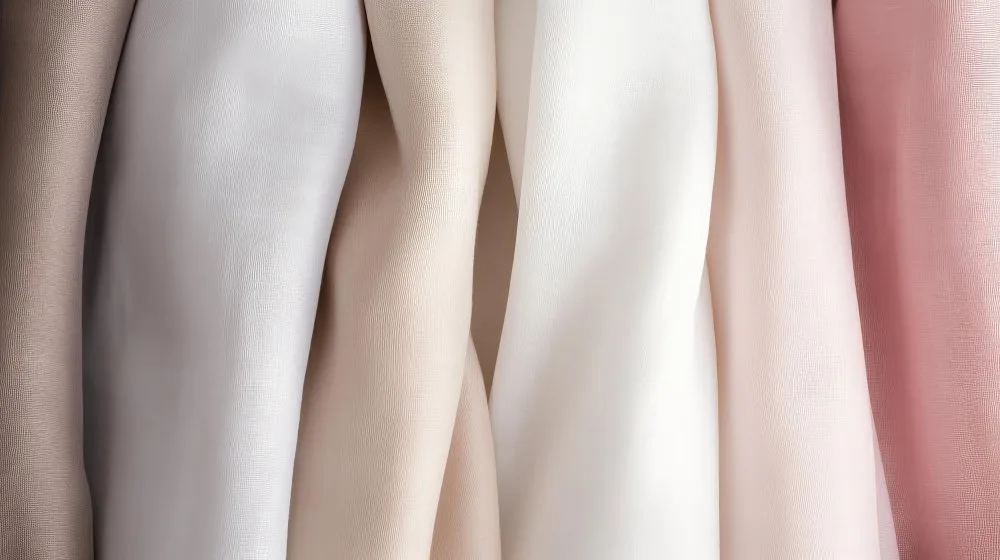
Not all silk is created equal. The type of silkworm, weaving method, and processing techniques create dramatically different fabrics. Let’s break down the most popular types:
Not sure which silk type is right for you? Take our Silk Type Selector Quiz to find the perfect match for your project in just 2 minutes.
By Source (Types of Indian Silk and Beyond)
1. Mulberry Silk
What it is: The most common and highest quality silk, produced by Bombyx mori silkworms that feed only on mulberry leaves.
Characteristics: Perfectly smooth, uniform texture with natural shine. Strongest and most durable silk type.
Best for: High-end fashion, luxury bedding, wedding dresses, ties
Price range: $$$$
Is mulberry silk real silk? Yes, it’s 100% natural silk and considered the finest variety available.
2. Tussar Silk (Wild Silk)
What it is: Made from wild silkworms that feed on oak and juniper trees, mainly produced in India.
Characteristics: Natural golden or beige color, coarser texture than mulberry, matte finish with unique texture.
Best for: Sarees, ethnic wear, casual clothing, eco-friendly fashion
Price range: $$ – $$$
3. Eri Silk (Peace Silk or Ahimsa Silk)
What it is: Produced from Samia ricini silkworms that feed on castor plants. Called “peace silk” because moths are allowed to emerge before harvesting.
Characteristics: Soft, warm, wool-like texture. Matte finish, very durable.
Best for: Winter clothing, jackets, scarves, ethical fashion
Price range: $$$ – $$$$
4. Muga Silk
What it is: Rare silk produced exclusively in Assam, India, from Antheraea assamensis silkworms.
Characteristics: Natural golden color, extremely durable, retains shine for years.
Best for: Traditional Indian garments, luxury items, sarees
Price range: $$$$$
5. Spider Silk
What it is: Produced by spiders rather than silkworms, extremely rare and mostly experimental.
Characteristics: Strongest natural fiber known, lightweight, incredible elasticity.
Best for: Research, medical applications, specialty items
Price range: Not commercially available
By Weave and Finish
6. Silk Charmeuse
Characteristics: Satin weave with glossy front and matte back, fluid drape, lightweight.
Best for: Lingerie, evening gowns, blouses, pillowcases
Weight: 12-30 momme
7. Silk Satin
Characteristics: Similar to charmeuse but heavier, with luxurious sheen and smooth float on the surface.
Best for: Wedding dresses, formal wear, high-end bedding
Weight: 20-40 momme
8. Silk Dupioni (Douppioni)
Characteristics: Made from double cocoons, creating characteristic slubs (bumps). Stiff, textured, with natural iridescence.
Best for: Suits, jackets, structured dresses, home decor
Another name: Dupion silk
9. Silk Chiffon
Characteristics: Sheer, lightweight, slightly stretchy. Very delicate and transparent.
Best for: Evening wear, scarves, layered garments, overlays
Weight: 5-8 momme
10. Silk Georgette
Characteristics: Lightweight, slightly crepe texture, more body than chiffon, sheer with a dull finish.
Best for: Blouses, dresses, flowing garments
Weight: 8-12 momme
11. Silk Crepe de Chine
Characteristics: Pebbled texture, matte to slight sheen, good drape, opaque.
Best for: Dresses, blouses, pants, versatile garments
Weight: 12-16 momme (standard), up to 40 momme (heavyweight)
12. Silk Organza
Characteristics: Stiff, crisp, sheer with slight shine. Holds shape well.
Best for: Bridal gowns, structured elements, interfacing, evening wear
Weight: 10-20 momme
13. Silk Taffeta
Characteristics: Crisp, smooth, rustling sound when moved. Holds shape excellently.
Best for: Ball gowns, structured dresses, curtains
Weight: 18-25 momme
14. Silk Habotai (China Silk)
Characteristics: Lightweight, soft, subtle shine. Most affordable silk option.
Best for: Lining, scarves, simple garments, beginners
Weight: 5-12 momme
15. Raw Silk (Silk Noil)
Characteristics: Nubby texture, matte finish, similar feel to cotton. Made from shorter fibers.
Best for: Casual wear, home textiles, upholstery
Price range: $ – $$
16. Silk Jersey
Characteristics: Knit (not woven), stretchy, drapes beautifully, very comfortable.
Best for: T-shirts, dresses, comfortable clothing
Weight: 8-14 momme
17. Silk Brocade
Characteristics: Rich patterns woven directly into fabric, often with metallic threads. Heavy and luxurious.
Best for: Formal wear, traditional garments, home decor
Weight: 25+ momme
18. Silk Jacquard
Characteristics: Intricate woven patterns, reversible design, raised motifs on front.
Best for: Formal wear, upholstery, decorative textiles
Weight: 20-35 momme
19. Silk Velvet
Characteristics: Soft pile on silk backing, luxurious texture, rich depth of color.
Best for: Evening wear, pillows, luxury home goods
Note: Often blended with viscose
20. Silk Shantung
Characteristics: Similar to dupioni but smoother, subtle slubs, crisp hand.
Best for: Suits, dresses, structured garments
Weight: 18-25 momme
Understanding Silk Grades: 6A to Grade C

Not all silk is created equal. The grading system tells you about the quality, purity, and longevity of your silk. Here’s what you need to know:
Grade A Silk (6A – A)
Characteristics:
- Long, continuous silk strands
- Pearl white or ivory color before dyeing
- No impurities or irregularities
- Smooth, even texture
- Natural luminous sheen
- Highly breathable and lightweight
Subdivisions: Grade A is further divided into 6A (highest), 5A, 4A, 3A, 2A, and A.
6A Grade: The absolute best silk available. Used in luxury bedding, high-end fashion, and premium wedding dresses.
Uses: Luxury bedding, bridal gowns, high-end fashion, premium scarves
Price: $$$$ – $$$$$
Grade B Silk
Characteristics:
- Shorter silk floss instead of long strands
- Contains more clumps and irregularities
- Uneven texture with air pockets
- Less sheen than Grade A
- Slightly rough feel
Uses: Sarees, kurtas, kaftans, fashion industry garments, linings
Price: $$ – $$$
Grade C Silk
Characteristics:
- Innermost cocoon layer
- Yellowish appearance with brown dots
- Cotton-like, rough texture
- No natural shine
- Less breathable
- Lower durability
Uses: Budget silk products, fillings, lower-end items
Price: $
Note: Avoid Grade C for clothing or bedding that touches your skin.
Pro Tip: When shopping, look for labels that specify “Grade 6A” or “Grade A” silk. If the grade isn’t mentioned, it’s likely Grade B or C. Use our Fabric Identification Quiz to test your knowledge.
Properties and Benefits of Silk
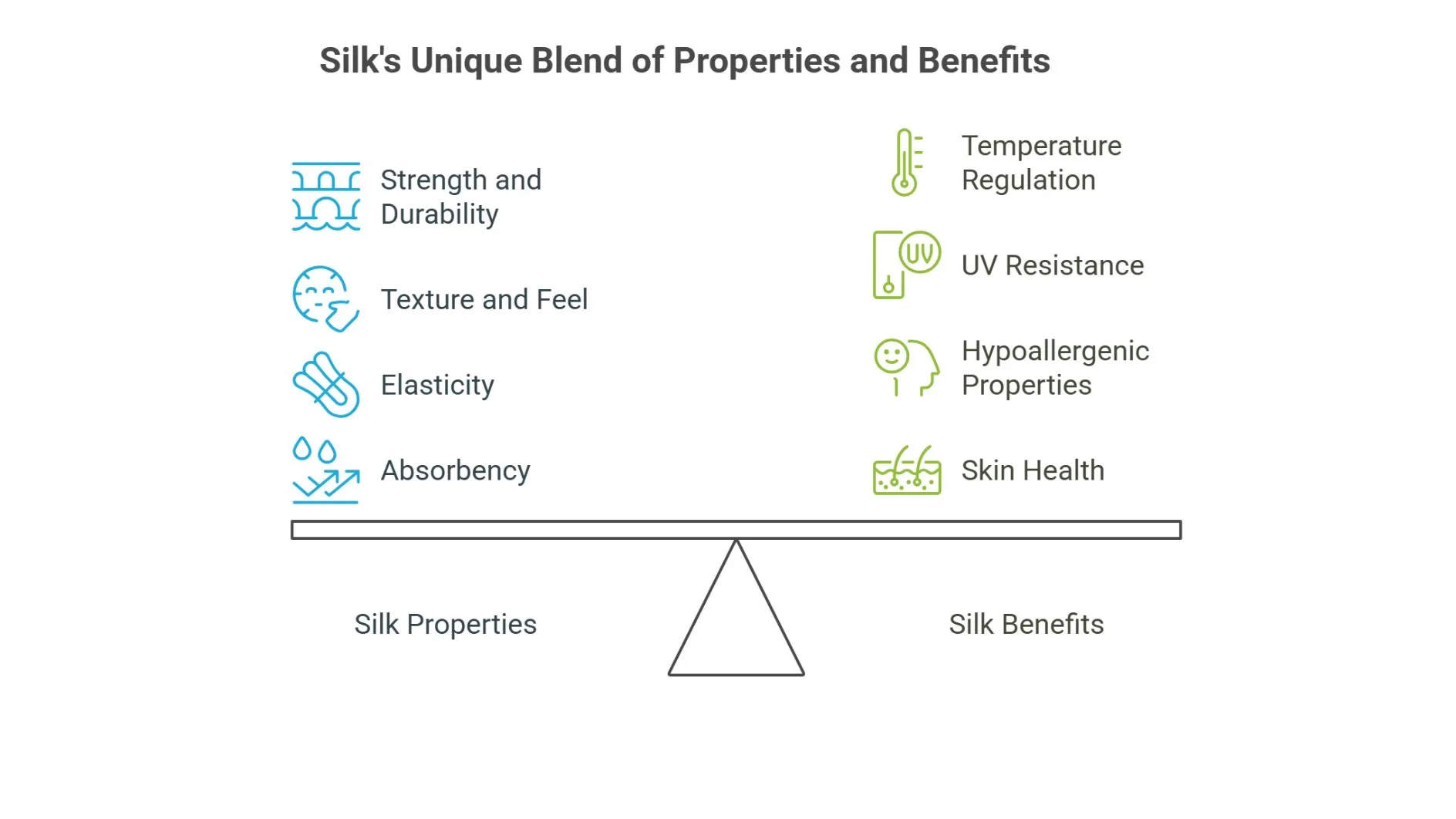
What makes silk so special? Let’s look at the science behind the softness:
Physical Properties
Strength and Durability: Silk is one of the strongest natural fibers. A silk fiber has the same tensile strength as a steel fiber of the same diameter. However, it does lose some strength when wet.
How long does silk last? With proper care, high-quality silk garments can last 20-30 years or more. Silk bedding typically lasts 10-15 years with regular use.
Texture and Feel: Silk fibers have a triangular cross-section that reflects light, creating that signature shine. The smooth surface feels cool and soft against skin, making it perfect for sensitive skin types.
Elasticity: Silk has natural give and returns to its shape after stretching (within limits). This makes it comfortable for clothing that moves with your body.
Absorbency: Silk can absorb up to 30% of its weight in moisture without feeling damp. This makes it comfortable in humid weather and helps wick sweat away from your body.
Functional Benefits
Temperature Regulation: This is silk’s superpower. Is silk for summer or winter? Actually, both! Silk naturally insulates in cold weather and wicks moisture in hot weather, keeping you comfortable year-round.
Breathability: Unlike synthetic fabrics, silk allows air to circulate, reducing overheating and keeping you fresh throughout the day.
UV Resistance: Silk blocks about 97% of UV radiation, offering natural sun protection (though you should still wear sunscreen!).
Hypoallergenic Properties: Is silk fabric good for sensitive skin? Yes! Silk naturally resists dust mites, mold, and fungus, making it perfect for people with allergies or skin sensitivities.
Is silk good for your skin? Absolutely. Silk’s smooth surface reduces friction against skin, which can minimize wrinkles and prevent hair breakage while you sleep. It also doesn’t absorb moisture from your skin like cotton does, helping maintain natural hydration.
Is silk healthier than cotton? Each has benefits. Silk is better for skin and hair health, temperature regulation, and allergies. Cotton is more durable for everyday wear, easier to care for, and more affordable. Read our detailed comparison on cotton vs polyester to understand fabric differences.
Advantages and Disadvantages of Silk
Advantages of Silk
- Luxurious feel and appearance: Unmatched softness and natural shine
- Temperature regulation: Comfortable in all seasons
- Strength and durability: Lasts for decades with proper care
- Hypoallergenic: Perfect for sensitive skin and allergies
- Moisture-wicking: Keeps you dry and comfortable
- Skin and hair benefits: Reduces friction and retains moisture
- Natural sheen: Looks elegant without being overly shiny
- Dye absorption: Takes color beautifully with rich, vibrant hues
- Biodegradable: Natural and eco-friendly when production is ethical
- Odor-resistant: Naturally neutralizes odors unlike synthetic fabrics
Disadvantages of Silk
- High cost: Labor-intensive production makes it expensive
- Delicate care requirements: Can’t just toss it in the washing machine
- Water sensitivity: Can water spot and loses strength when wet
- Sun sensitivity: Prolonged sun exposure can fade and weaken fibers
- Wrinkles: Some types wrinkle easily (depends on weave)
- Stain susceptibility: Hard to remove some stains, especially perspiration
- Shrinkage risk: Can shrink if washed incorrectly
- Ethical concerns: Traditional production kills silkworms
- Static electricity: Can build up static in dry conditions
- Availability: Not as widely available as cotton or synthetic fabrics
What are the negatives of silk? The main drawbacks are cost and care requirements. Silk demands gentle handling, special detergents, and often professional cleaning. It can also water spot, shrink, or fade if not properly cared for.
How to Tell if a Fabric is Real Silk
With so many synthetic “silk-like” fabrics on the market, how can you tell if you’re getting the real deal? Here are proven tests:
Visual and Touch Tests
Quick Silk Authentication Guide
If it’s too cheap, it’s probably not silk. Real silk rarely sells for under $20 per yard.
Look for “100% silk” or just “silk.” Terms like “silk satin” or “silky” usually mean polyester.
Real silk feels cool to the touch initially and warms up quickly. It should feel smooth but with a slight texture, not slippery like polyester.
Scrunch the fabric. Real silk makes a distinctive rustling sound called “scroop.”
Silk has a subtle, natural sheen that changes with movement. Synthetic fabrics have a uniform, artificial shine.
The Burn Test (Most Reliable)
Warning: Only do this test on a small hidden area or loose thread. Do it in a safe, well-ventilated area with water nearby.
How to Perform the Burn Test
- Pull out a small thread or cut a tiny piece from a hidden seam
- Hold it with tweezers over a fireproof surface
- Light it with a match or lighter
- Observe what happens
| Test Result | Real Silk | Polyester |
|---|---|---|
| Burning | Burns slowly, curls away from flame | Burns quickly, melts |
| Smell | Smells like burning hair/feathers | Smells like burning plastic |
| Ash | Crumbles to fine, dark powder | Forms hard, plastic-like beads |
| Self-extinguishing | Yes, stops burning when flame is removed | No, continues to melt |
Want to test your silk identification skills? Take our Silk Identification Quiz and learn to spot authentic silk every time.
How to Wash and Care for Silk
Proper care is what separates silk that lasts decades from silk that’s ruined after one wash. Here’s everything you need to know:
Can You Wash Silk?
What happens if I wash 100% silk? You can wash silk, but you must do it correctly. Improper washing can cause shrinkage, water spots, color bleeding, or permanent damage. Always check the care label first, some silk items (especially those with embellishments or dry-clean-only labels) should go to professionals.
What happens if silk gets wet? Silk loses some strength when wet and is more prone to stretching or tearing. Water can also leave spots if not handled properly. That said, silk can absolutely be washed, you just need to be gentle.
Hand Washing Silk (Recommended Method)
Step-by-Step Silk Hand Washing Guide
- Fill a clean basin with cool or lukewarm water (never hot, 30°C/86°F maximum)
- Add gentle detergent: Use a mild, pH-neutral detergent specifically for silk or delicates. Avoid harsh chemicals, bleach, or biological detergents
- Submerge the garment: Gently swish it around for 3-5 minutes. Don’t scrub, twist, or wring
- Rinse thoroughly: Use cool, clean water until all soap is gone. You may need 2-3 rinses
- Add white vinegar (optional): A tablespoon of white vinegar in the final rinse helps restore shine and remove detergent residue
- Remove excess water: Gently press (don’t wring) the garment. Roll it in a clean, dry towel to absorb more water
- Lay flat to dry: Place on a clean, dry towel away from direct sunlight and heat. Reshape while damp
Get personalized care instructions: Use our Silk Care Calculator to get custom washing, drying, and storage recommendations based on your specific silk type and garment.
Check out our detailed Silk Care Guide for more tips on maintaining your silk items.
Machine Washing Silk (Use Caution)
Some silk items can be machine washed, but proceed carefully:
- Only wash sturdy silk items (avoid delicate chiffon or heavily embellished pieces)
- Use a mesh laundry bag to protect the fabric
- Select the delicate/silk cycle with cold water
- Use minimal spin (or no spin if possible)
- Remove immediately to prevent wrinkling
How Often to Wash Silk
How often does silk need to be washed? It depends on the item:
- Silk bedding: Every 1-2 weeks
- Silk shirts/blouses: After 2-3 wears (unless visibly soiled)
- Silk dresses: After each wear if you perspired, otherwise after 2 wears
- Silk scarves: Every 4-5 wears or as needed
- Silk pajamas: Weekly or twice weekly
Silk naturally resists odors, so it doesn’t need washing as frequently as cotton. Airing items out between wears can extend time between washings.
Drying Silk
- Never use a dryer: Heat damages silk fibers and causes shrinkage
- Avoid direct sunlight: UV rays fade colors and weaken fibers
- Lay flat: Best method that maintains shape
- Hang-dry (carefully): Only for garments that won’t stretch. Use padded hangers
- Air circulation: Ensure good airflow to prevent mildew
Ironing and Steaming
Can 100% silk be ironed? Yes, but carefully:
- Iron while still slightly damp for best results
- Use the lowest heat setting (silk/low setting)
- Always iron on the reverse side
- Use a pressing cloth to protect the fabric
- Don’t use steam directly on silk, it can water spot
- Better option: Use a fabric steamer from a distance
Does silk fabric wrinkle easily? It depends on the weave. Loose weaves like crepe de chine and chiffon wrinkle less. Tighter weaves like dupioni and taffeta wrinkle more easily. Hanging garments properly and storing correctly helps prevent wrinkling.
Stain Removal
- Act immediately: Blot (don’t rub) fresh stains with a clean, damp cloth
- Avoid heat: Don’t expose stained silk to heat, which sets stains permanently
- Test first: Always test cleaning solutions on a hidden area
- For oil-based stains: Sprinkle with cornstarch or talcum powder, let sit for 30 minutes, brush off gently, then wash
- For water-based stains: Gently dab with cool water and mild soap
- Stubborn stains: Take to a professional cleaner who specializes in silk
Does salt water ruin silk? Yes, salt water can damage silk fibers and leave stains. If silk gets salt water on it, rinse immediately with fresh cool water and wash as soon as possible.
Storage Tips
- Store in a cool, dry place away from direct sunlight
- Use breathable garment bags (not plastic, which traps moisture)
- Avoid hanging delicate silk pieces, fold them with acid-free tissue paper
- Keep away from rough surfaces that can snag
- Don’t store silk folded for too long in the same place, creases can become permanent
- Cedar blocks help repel insects without harsh chemicals
Does Silk Shrink?
Does silk shrink a lot? Silk can shrink 8-10% if exposed to high heat or washed incorrectly. Pre-shrinking fabric before sewing is recommended. Once shrunk, silk usually can’t be restored to its original size.
Should you size up for silk? It’s not always necessary, but if you’re worried about shrinkage or prefer a looser fit, ordering one size up can be smart, especially for items that will need frequent washing.
Silk vs Other Fabrics
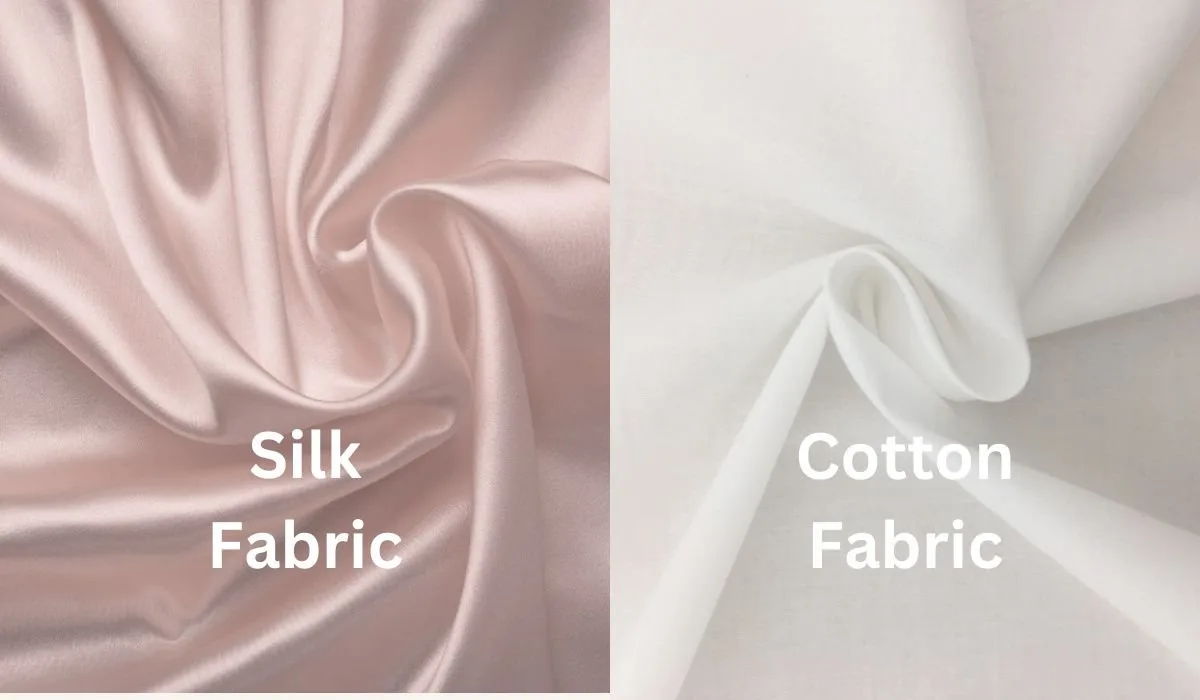
Which is Better: Cotton or Silk?
This is the ultimate fabric showdown. The answer depends on what you need:
| Feature | Silk | Cotton |
|---|---|---|
| Softness | Luxuriously smooth and soft | Soft but can feel rougher |
| Temperature | Regulates, works for all seasons | Breathable but can trap heat when wet |
| Durability | Strong but requires careful handling | Very durable, can handle rough use |
| Care | Delicate, hand wash or dry clean | Easy, machine wash and dry |
| Cost | $$$$ | $-$$ |
| Allergies | Hypoallergenic, resists dust mites | Can harbor dust mites |
| Moisture | Wicks moisture away from skin | Absorbs moisture but holds onto it |
| Skin benefits | Prevents wrinkles, retains skin moisture | Can absorb skin’s natural oils |
| Best for | Luxury items, special occasions, bedding | Everyday wear, children’s clothes, casual items |
For more on cotton, read our Cotton Care Guide.
Which Fabric is Closest to Silk?
If you love silk but want alternatives, consider:
- Rayon/Viscose: Drapes like silk, more affordable, but not as durable
- Tencel/Lyocell: Smooth, breathable, eco-friendly, similar feel
- Polyester satin: Looks shiny like silk but lacks breathability and feels different
- Bamboo fabric: Soft, hypoallergenic, similar benefits for bedding
- Cupro: Made from cotton linter, very silk-like drape
None perfectly replicate silk’s unique combination of properties, but these come close for specific applications. Learn more in our guide on natural and synthetic fabrics.
Uses and Applications

Is silk a good fabric? For many applications, absolutely. Here’s where silk shines:
Fashion and Clothing
- Evening wear and formal dresses: Silk’s drape and shine make it perfect for special occasions
- Blouses and shirts: Comfortable, professional, and elegant
- Wedding dresses: Traditional choice for its beauty and symbolism
- Lingerie: Smooth against skin, temperature-regulating
- Ties and scarves: Holds knots well, takes dye beautifully
- Linings: Adds luxury and helps garments slide on easily
- Sleepwear: Comfortable, temperature-regulating, skin-friendly
Home Textiles
- Bedding: Pillowcases, sheets, duvet covers, benefits skin and hair
- Curtains and drapes: Elegant drape, filters light beautifully
- Upholstery: Luxurious appearance for formal furniture
- Decorative pillows: Adds texture and elegance to rooms
- Wall coverings: Rare but stunning for luxury interiors
Specialized Applications
- Medical sutures: Silk’s strength and biocompatibility
- Parachutes: Historical use due to strength-to-weight ratio
- Bicycle tires: High-end racing tires still use silk
- Fishing lines: Traditional use for strength and flexibility
- Art conservation: Used to back and repair delicate textiles
Examples of Silk in Fashion Today
Silk remains a staple in fashion houses worldwide. In 2025, you’ll see:
- Silk slip dresses in minimalist designs
- Vintage-inspired silk blouses with modern cuts
- Silk scarves as statement accessories
- Mixed-texture outfits pairing silk with denim or leather
- Sustainable silk collections from eco-conscious brands
For inspiration on styling silk pieces, check out our guide to understanding silk fabric.
Sewing with Silk: Tips and Techniques
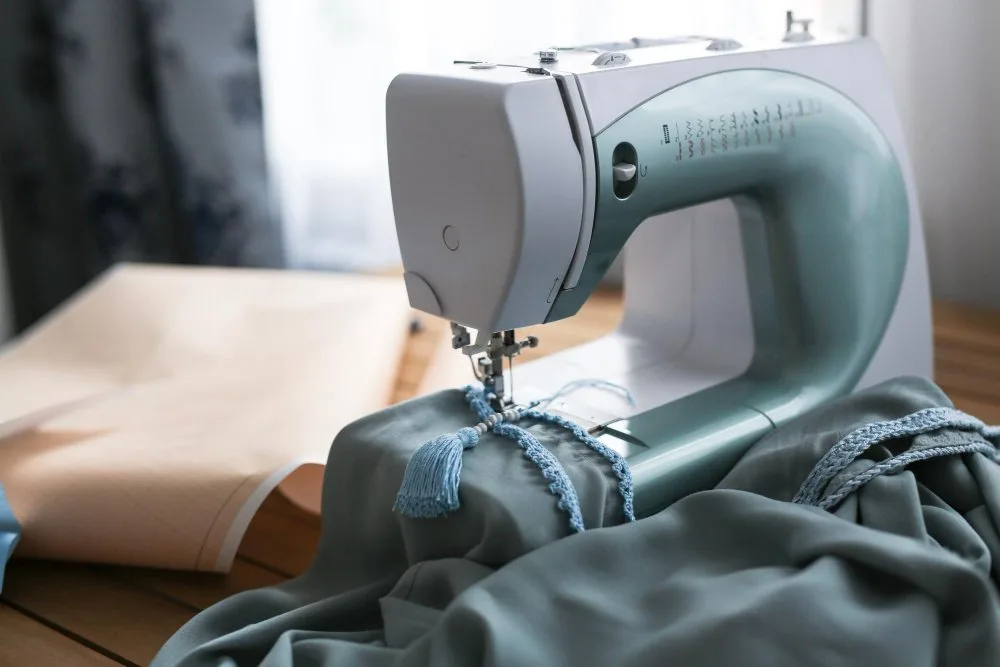
Is silk fabric hard to sew? Silk can be challenging for beginners because it’s slippery and delicate, but with the right techniques, it’s definitely manageable. Here’s everything you need to know:
Can You Sew Silk on a Sewing Machine?
Yes! You don’t need a special machine, but you do need the right setup:
Essential Tools for Sewing Silk
- Needle: Size 60/8 or 70/10 sharp or microtex needle (very important, use new, sharp needles)
- Thread: Fine silk or polyester thread (not cotton, which is too thick)
- Pins: Superfine silk pins or use weights instead to avoid marking
- Scissors: Very sharp fabric scissors or rotary cutter
- Presser foot: Walking foot or roller foot helps prevent slipping
What size needle do I use for sewing silk? Use a size 60/8 or 70/10 needle. These fine needles won’t snag or damage delicate silk fibers. Replace your needle every 4-6 hours of sewing.
Do you need special thread to sew silk? While not absolutely required, silk thread or fine polyester thread gives the best results. Cotton thread is too thick and can cause puckering. Match your thread weight to your fabric weight.
Preparing to Sew
- Pre-wash your silk: Unless it’s marked “dry clean only,” pre-wash to account for shrinkage
- Press carefully: Iron on low heat with a press cloth before cutting
- Use pattern weights: Pinning can leave permanent holes in some silks
- Mark with tailor’s chalk: Avoid pens that might bleed
- Cut with sharp tools: Dull scissors will snag silk
Does silk fray when cut? Yes, silk frays easily, especially looser weaves. You’ll need to finish seams properly to prevent fraying.
Planning a silk sewing project? Use our Silk Yardage Calculator to determine exactly how much fabric you need, no more expensive mistakes or waste!
Sewing Techniques
What is the best stitch for silk fabric? Use a straight stitch with slightly shorter length (2-2.5mm) for most seams. For very delicate silk, a narrow zigzag (0.5mm width) can prevent puckering.
What tension to use when sewing silk? Reduce tension slightly (around 3-4 on most machines). Test on scraps first, you want smooth seams without puckering or loops.
Machine Settings for Silk
- Stitch length: 2-2.5mm (12-15 stitches per inch)
- Tension: Slightly lower than normal (3-4)
- Speed: Sew slowly for better control
- Presser foot pressure: Reduce if possible to prevent stretching
How to Sew Silk Without Fraying
Silk frays quickly, so proper seam finishing is important:
- French seams: Best for lightweight silk, encloses raw edges beautifully. Check our French Seam Tutorial
- Flat-fell seams: Strong and neat, good for shirts. See our Flat-Fell Seam Guide
- Zigzag stitch: Quick finish for seam allowances
- Serged/overlocked edges: If you have a serger
- Hong Kong finish: Elegant bias tape finish for unlined jackets
- Pinked edges: Works temporarily for non-ravelly silks
What Can I Sew with Silk Fabric?
Start with simpler projects if you’re new to silk:
Beginner-friendly silk projects:
- Simple scarves (no seams needed)
- Pillowcases
- Sleep masks
- Simple drawstring bags
Intermediate projects:
- Camisoles and simple tops
- Skirts with elastic waistbands
- Pajama pants
- Simple dresses
Advanced projects:
- Blouses with details
- Lined jackets
- Evening gowns
- Wedding dresses
Looking to start sewing? Check out our Beginner’s Guide to Sewing and Easy Sewing Projects for Beginners.
How to Stiffen Silk for Sewing
Sometimes silk is too drapey for structured projects. To add body:
- Interface: Use lightweight fusible interfacing (test on scraps first, low heat!)
- Underline: Add a layer of organza or lightweight cotton for structure
- Spray starch: Light application before cutting (wash test first)
- Choose stiffer silk: Taffeta and organza have natural body
Common Sewing Problems and Solutions
| Problem | Cause | Solution |
|---|---|---|
| Puckered seams | Tension too tight or stitches too long | Reduce tension, shorten stitch length, sew slower |
| Fabric slipping | Silk is naturally slippery | Use walking foot, tissue paper under fabric, or silk pins |
| Skipped stitches | Wrong or dull needle | Use new sharp/microtex needle size 60-70 |
| Snagging | Rough hands, nails, or worn needle | Moisturize hands, file nails, change needle |
| Water spots from pressing | Steam or water droplets | Use dry iron with press cloth, no steam |
Sustainability and Ethics in Silk Production
Silk production raises important ethical questions that conscious consumers should understand:
The Ethical Concerns
Traditional silk production (known as “conventional silk”) involves boiling silkworm cocoons with the pupae still inside, killing them before they can emerge as moths. It takes about 2,500 silkworms to produce one pound of silk.
Many people find this practice problematic, especially animal rights advocates who argue that silkworms are living creatures deserving of ethical treatment.
Peace Silk (Ahimsa Silk)
Peace silk, also called Ahimsa silk or non-violent silk, allows moths to emerge naturally before harvesting the cocoons. This method:
- Pros: No animals harmed, more ethical, still beautiful and functional
- Cons: More expensive (longer production time), slightly less lustrous (broken filaments), limited availability
Eri silk is the most common type of peace silk. It’s naturally produced this way because Eri moths exit through an opening rather than breaking through.
Environmental Impact
Positive aspects:
- Natural, biodegradable fiber
- Mulberry trees absorb CO2
- No pesticides needed for mulberry cultivation
- Can be produced with minimal water
- Long-lasting products reduce waste
Concerns:
- Some producers use chemical dyes (look for natural dyes)
- Energy-intensive degumming and processing
- Monoculture mulberry plantations can reduce biodiversity
- Labor practices vary widely by region
How to Buy Ethical Silk
- Look for “Peace Silk” or “Ahimsa Silk” certifications
- Research brands’ production methods
- Choose organic silk (no chemical pesticides or dyes)
- Support fair trade certified producers
- Ask retailers about their sourcing
- Consider vintage or secondhand silk
Learn more about sustainable choices in our article on Fast Fashion vs Slow Fashion in 2025.
Silk Trends in 2025
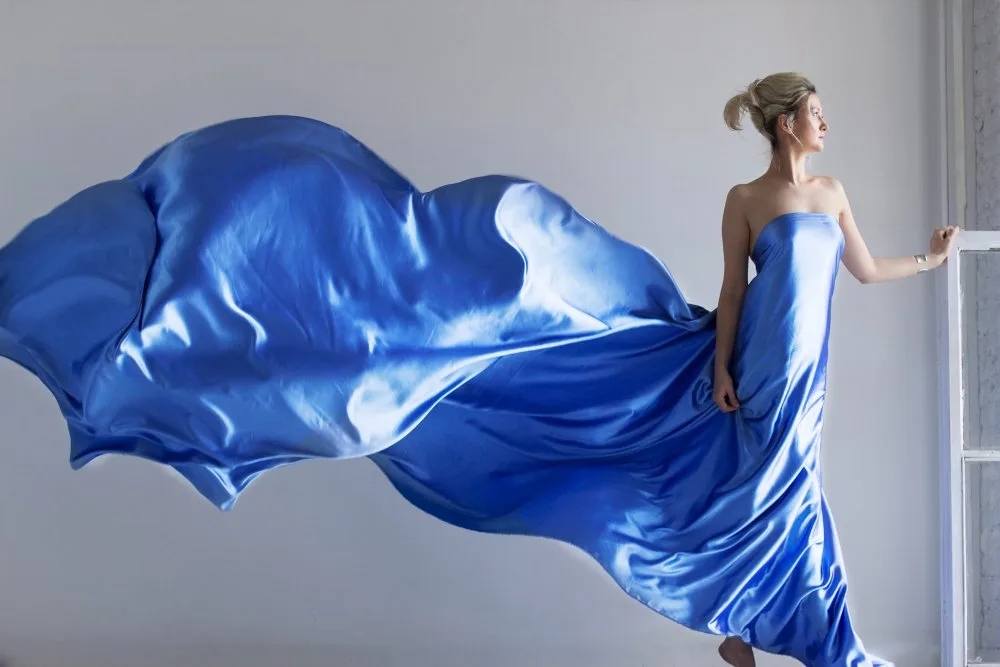
Silk is making a strong comeback in 2025, driven by nostalgia and sustainability concerns. Here’s what’s trending:
Fashion Trends
- Vintage-inspired silk blouses: Think grandma blouses with modern touches, puff sleeves, high necks, and delicate details
- Silk slip dresses: 90s minimalism is back, with silk slips layered over t-shirts or worn alone
- Mixed textures: Pairing silk with contrasting fabrics like denim, leather, and chunky knits
- Bold silk prints: Moving beyond solid colors to graphic patterns and artistic designs
- Sustainable silk: Peace silk and organic silk are gaining market share as consumers prioritize ethics
- Natural colors: Undyed or naturally dyed silk in earthy tones
Home Decor Trends
- Silk bedding: Growing popularity as people invest in sleep quality
- Textured silk pillows: Raw silk and dupioni for visual interest
- Silk curtains: Replacing heavy drapes with flowing silk panels
- Statement headboards: Upholstered in luxurious silk fabrics
For more on what’s hot in textiles, read our 2025 Fabric Trends guide.
Buying Guide: What to Look For

Ready to buy silk? Here’s how to make smart choices:
Overwhelmed by choices? Our Silk Type Selector Quiz helps you find the perfect silk for your needs, whether you’re shopping for fashion, home decor, or sewing projects.
Understanding Momme Weight
Momme (mm) is the unit of measurement for silk weight. One momme equals 4.34 grams per square meter.
| Momme Weight | Description | Best For |
|---|---|---|
| 5-8mm | Very lightweight, sheer | Chiffon, scarves, linings |
| 12-19mm | Lightweight to medium | Blouses, dresses, lightweight pajamas |
| 19-25mm | Medium to heavy | Bedding, quality garments, winter sleepwear |
| 25-30mm | Heavy | Luxury bedding, upholstery, structured garments |
| 30mm+ | Very heavy | Upholstery, curtains, specialty items |
Higher momme = more durable and opaque (also more expensive).
Price Expectations
- Fabric by the yard: $20-$100+ depending on type and grade
- Silk blouses: $100-$500+
- Silk dresses: $200-$2,000+
- Silk bedding (pillowcase): $30-$100
- Silk sheets (queen set): $200-$800+
If it seems too cheap, it’s probably not real silk or is very low grade.
What to Look for When Shopping
- Label: Should say “100% silk” or just “silk”
- Grade: Look for Grade A or specific grade listed
- Momme weight: Higher is generally better (but heavier)
- Origin: China, India, Japan, Thailand (doesn’t necessarily indicate quality)
- Care instructions: Should be specific to silk
- Return policy: Important for online purchases
- Ethical certifications: Peace silk, organic, fair trade labels
Red Flags
- Extremely low prices ($5-10 per yard is suspicious)
- Vague labels like “silky” or “silk-like”
- No fiber content listed
- Overly shiny, artificial appearance
- Perfectly uniform texture (real silk has slight irregularities)
- Seller can’t answer questions about grade or momme weight
Where to Buy Silk
- Fabric stores: Can see and feel before buying
- Online fabric retailers: Often better prices and selection
- Luxury department stores: High-quality, vetted brands
- Direct from mills: Best prices for bulk orders
- Vintage shops: Unique finds, sustainable option
- Specialty silk retailers: Expert knowledge and quality assurance
Frequently Asked Questions About Silk Fabric
Conclusion
After exploring everything from sericulture to sewing techniques, you’re now equipped to make informed decisions about silk. Let’s wrap up with the essentials:
Is silk a good fabric? For many purposes, absolutely. Silk offers a unique combination of luxury, comfort, and functionality that no other fabric can match. Its temperature-regulating properties, hypoallergenic nature, and skin benefits make it worth the investment for items that touch your body regularly, bedding, sleepwear, and special garments.
However, silk isn’t perfect for everyone or every situation. If you need something durable for active kids, easy-care for busy lifestyles, or budget-friendly for everyday wear, cotton or synthetic alternatives might serve you better.
Key Takeaways
- Quality matters: Grade 6A silk outperforms lower grades significantly. Don’t just look at price, check the grade, momme weight, and fiber content.
- Care is critical: Silk lasts decades with proper care but can be ruined quickly with improper washing. Always follow care instructions and when in doubt, hand wash in cool water.
- Type determines use: Match the silk type to your project. Don’t use chiffon for upholstery or taffeta for flowing dresses.
- Test before you buy: Use the burn test, touch test, and price check to verify authenticity. Real silk has distinctive properties you can learn to identify.
- Consider ethics: If animal welfare concerns you, seek out peace silk or ethical alternatives. Your purchasing decisions support production practices.
- Start small: If new to silk, begin with a pillowcase or scarf before investing in expensive garments or bedding sets.
- Sewing silk requires patience: Use proper needles, thread, and techniques. Practice on scraps before cutting into expensive fabric.
Final Recommendations
Best for beginners: Start with silk habotai or charmeuse in 12-19mm. These are affordable, versatile, and easier to care for than delicate chiffons or heavily structured brocades.
Best investment pieces: Silk pillowcases and bedding offer daily benefits for skin and hair. Grade 6A mulberry silk in 22-25mm provides the best balance of comfort and durability.
Best for special occasions: Silk dupioni, charmeuse, or crepe de chine for formal wear. These drape beautifully and photograph well.
Best ethical option: Eri silk (peace silk) or certified organic silk from transparent suppliers. Yes, it costs more, but you’re supporting practices aligned with your values.
Best silk alternative: If silk isn’t right for you, try Tencel for similar drape and comfort, or high-quality bamboo fabric for bedding. Neither perfectly replicates silk, but both offer some similar benefits at lower cost and easier care.
Next Steps
Ready to experience silk for yourself? Use our interactive tools to find your perfect match:
- Take the Silk Type Selector Quiz to discover the best silk for your needs
- Use the Silk Identification Quiz to test your knowledge and learn to spot real silk
- Calculate your fabric needs with the Silk Yardage Calculator
- Get personalized care instructions from our Silk Care Calculator
- Explore more fabrics in our Common Fabric Types Guide
Whether you’re buying your first silk scarf or creating a custom wedding dress, understanding this remarkable fabric helps you appreciate its beauty and make choices that bring you joy for years to come. Silk has captivated humans for 5,000 years, now you know why.
Happy shopping, sewing, and sleeping on your silk!
Further Reading: For authoritative information on silk production and standards, visit the Food and Agriculture Organization, the Encyclopaedia Britannica’s Silk Entry, and ScienceDirect’s Silk Fabric Research.

